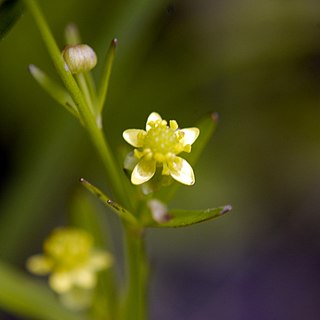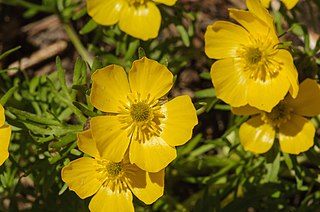
Ranunculus is a large genus of about 1700 to more than 1800 species of flowering plants in the family Ranunculaceae. Members of the genus are known as buttercups, spearworts and water crowfoots.

Ranunculus repens, the creeping buttercup, is a flowering plant in the buttercup family Ranunculaceae, native to Europe, Asia and northwestern Africa. It is also called creeping crowfoot and sitfast.

Ranunculus bulbosus, commonly known as bulbous buttercup or St. Anthony's turnip, is a perennial flowering plant in the buttercup family Ranunculaceae. It has bright yellow flowers, and deeply divided, three-lobed long-petioled basal leaves.

Ranunculus acris is a species of flowering plant in the family Ranunculaceae, and is one of the more common buttercups across Europe and temperate Eurasia. Common names include meadow buttercup, tall buttercup, common buttercup and giant buttercup.

Ranunculus jovis is a species of buttercup known by the common name Utah buttercup or Jupiter buttercup. It is native to the mountain west of the United States, from Nevada to Wyoming. It is a petite plant, growing a few centimeters tall on hairless stems with a few deeply divided fingerlike leaves at the base. It produces yellow flowers with five rounded petals, yellow stamens around a central nectary.
Ranunculus canus is a species of buttercup known by the common name Sacramento Valley buttercup. It is endemic to California, where it grows in the Central Valley and adjacent mountain foothills, and the Transverse Ranges just south. It grows in grassland and meadows in woodland and forest habitat. This plant can be very similar in appearance to the California buttercup, and may be difficult to distinguish from it. It is variable in form. In general the plant is a perennial herb producing erect, usually hairy stems up to 65 centimeters tall. The hairy leaves are each made up of three leaflets, leaves occurring lower on the plant with wider leaflets which may be notched to lobed, and upper leaves with narrow, toothed leaflets. The flower has up to 23 shiny yellow petals and many yellow stamens and pistils at the center. The fruit is an achene, borne in a spherical cluster of 11 or more.

Ranunculus eschscholtzii is a species of buttercup flower known by the common name Eschscholtz's buttercup.

Ranunculus flabellaris is a species of flowering plant in the buttercup genus, Ranunculus, known by the common name yellow water buttercup. It is native to much of North America, including the southern half of Canada and most of the United States.
Ranunculus gormanii is a species of buttercup known by the common name Gorman's buttercup. It is native to Oregon and northern California, where it grows in the Klamath Mountains and a section of the southern Cascade Range. It can be found in moist areas in mountain forests and meadows. It is a perennial herb producing prostrate stems which extend along the ground up to 20 centimeters in length, sometimes rooting at nodes that come in contact with wet substrate. The leaves have oval blades up to 4 centimeters wide which are borne on petioles up to 7 centimeters in length. Flowers have 5 to 7 shiny yellow petals each a few millimeters long and many stamens and pistils. The fruit is an achene borne in a spherical cluster of up to 15.
Ranunculus lobbii is a species of buttercup known by the common name Lobb's buttercup, or Lobb's aquatic buttercup. It is native to a few areas in western North America, where it is reported from British Columbia, Oregon, and northern California. It is an aquatic plant, growing in various types of shallow-water habitat, including forest ponds and vernal pools. It is an annual herb producing submerged stems 20 to 80 centimeters long which may float at the surface. The blades of the leaves are tiny and divided into threadlike segments. If any leaves develop on stem parts which are exposed to air they are much different in morphology, developing larger, more robust leaves. Flowers have generally 5 petals which are white in color and about half a centimeter long. Many stamens and pistils fill the center of the flower. The fruit is an achene borne in a spherical cluster.
Ranunculus populago is a species of buttercup known by the common names popular buttercup and mountain buttercup. It is native to the Pacific Northwest and surrounding areas in the United States, where it grows in wet habitat, such as bogs, streambanks, and moist mountain meadows. It is a perennial herb producing an upright, mostly hairless stem up to about 30 centimeters in maximum height. Leaves have oval blades borne on long petioles. The flower has usually five or six shiny yellow petals each a few millimeters long around a central nectary and many stamens and pistils. The fruit is an achene borne in a spherical cluster.

Ranunculus uncinatus is a species of buttercup known by the common names woodland buttercup and little buttercup. It is native to western North America from Alaska to California to New Mexico, where it grows in wet, wooded habitat such as forest streambanks.

Ranunculus recurvatus, the blisterwort or hooked crowfoot, is a plant species of the genus Ranunculus in the family Ranunculaceae native to eastern North America. It is an early-flowering plant of moist deciduous woods from central Quebec south to Florida.

Ranunculus auricomus, known as goldilocks buttercup or Greenland buttercup, is a perennial species of buttercup native to Eurasia. It is a calcicole typically found in moist woods and at the margins of woods. It is apomictic, and several hundred agamospecies have been recognised.
Ranunculus allenii, commonly known as Allen's buttercup, is a flowering plant in the crowfoot or buttercup family, Ranunculaceae. Generally found in wetlands in northern latitudes, it bears yellow flowers in summer, which are pollinated by insects.

Ranunculus abortivus is a species of flowering plant in the buttercup family, Ranunculaceae. Its common names include littleleaf buttercup, small-flower crowfoot, small-flowered buttercup, and kidneyleaf buttercup. It is widespread across much of North America, found in all ten Canadian provinces as well as Yukon and the Northwest Territories, and most of the United States, except Hawaii, Oregon, California, and parts of the Southwest.

Ranunculus cortusifolius, also known as the Azores buttercup or Canary buttercup, is a plant species in the genus Ranunculus, family Ranunculaceae, the buttercup or crowfoot family. It grows on moister sites throughout the Azores, Madeira and Canary Islands but is widely cultivated elsewhere as an ornamental. There are reports of it having become naturalized in parts of California.

Ranunculus hispidus is a species of perennial flowering plant in the buttercup family, Ranunculaceae. It is commonly known as bristly buttercup or hispid buttercup. It is a small plant native to central and eastern North America that grows to a height up to 30 cm (1 ft) and has 5-petaled yellow flowers.

Ranunculus allegheniensis is a species of flowering plant in the buttercup family, Ranunculaceae. Its common names include Allegheny Mountain buttercup and Allegheny crowfoot.

Ranunculus adoneus, the alpine buttercup or snow buttercup, is a species of flowering plant. It is an alpine buttercup from the family Ranunculaceae. This species is mainly found in the Rocky Mountains in Colorado and Wyoming but can also be found in Idaho, northern Utah and eastern Nevada. Its typical habitat is short grass meadows near the edge of melting snow.
















